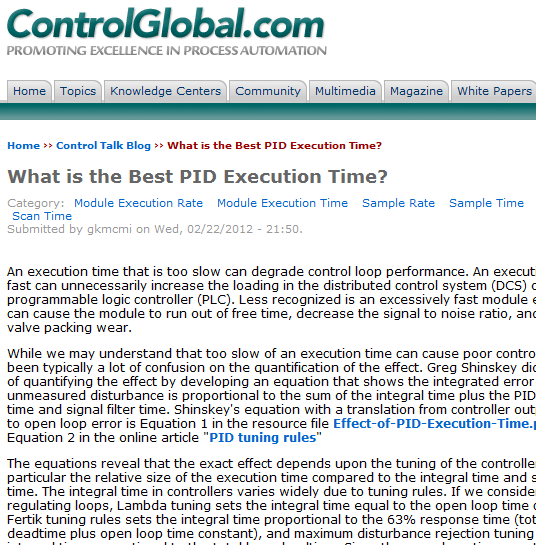 For those that have followed Greg McMillan or come upon his posts over at the ModelingAndControl.com blog, I wanted to share that he’s moving his process optimization wisdom over to the ControlGlobal.com Control Talk blog. In his ModelingAndControl.com post, Different but the Same, he writes:
For those that have followed Greg McMillan or come upon his posts over at the ModelingAndControl.com blog, I wanted to share that he’s moving his process optimization wisdom over to the ControlGlobal.com Control Talk blog. In his ModelingAndControl.com post, Different but the Same, he writes:
I chose the Control magazine for my new home to join Bela Liptak and Greg Shinskey who are frequent contributors. I had the honor of being inducted into the Control magazine Process Automation Hall of Fame the inaugural year with them. I consider Liptak and Shinskey to be my best source of practical information on process control.
The next wave of process control engineers needs to mind meld with this vast wealth of process control wisdom before they leave the stage.
Greg jumps right in to his new home with the post, What is the Best PID Execution Time? He opens:
An execution time that is too slow can degrade control loop performance. An execution time too fast can unnecessarily increase the loading in the distributed control system (DCS) or programmable logic controller (PLC). Less recognized is an excessively fast module execution time can cause the module to run out of free time, decrease the signal to noise ratio, and increase valve packing wear.
He highlights Greg Shinskey’s work in quantifying the effect of execution time in control performance:
…by developing an equation that shows the integrated error for an unmeasured disturbance is proportional to the sum of the integral time plus the PID execution time and signal filter time.
The post links to a couple of documents, which detail the equations involved.
Greg summarizes with takeaways for control engineers:
…the module execution time should be less than 10% of the integral time less the signal filter time as shown in Equation 3, greater than the half the % quantization error divided by the maximum % rate of change of the process variable as shown in Equation 4, and greater than the period of noise causing fluctuations in the PID output to exceed the final control element deadband as shown in Equation 5.
If you’re a process control engineer, you’ll want to add this site to your favorites or your RSS reader feeds.




